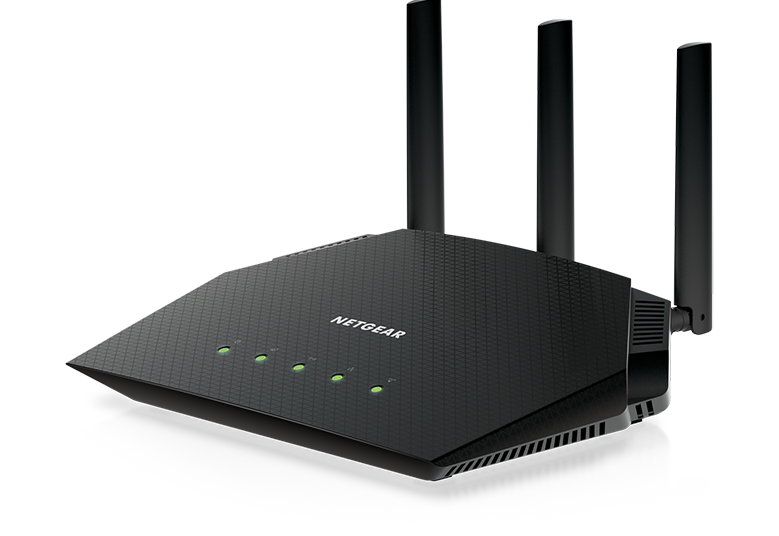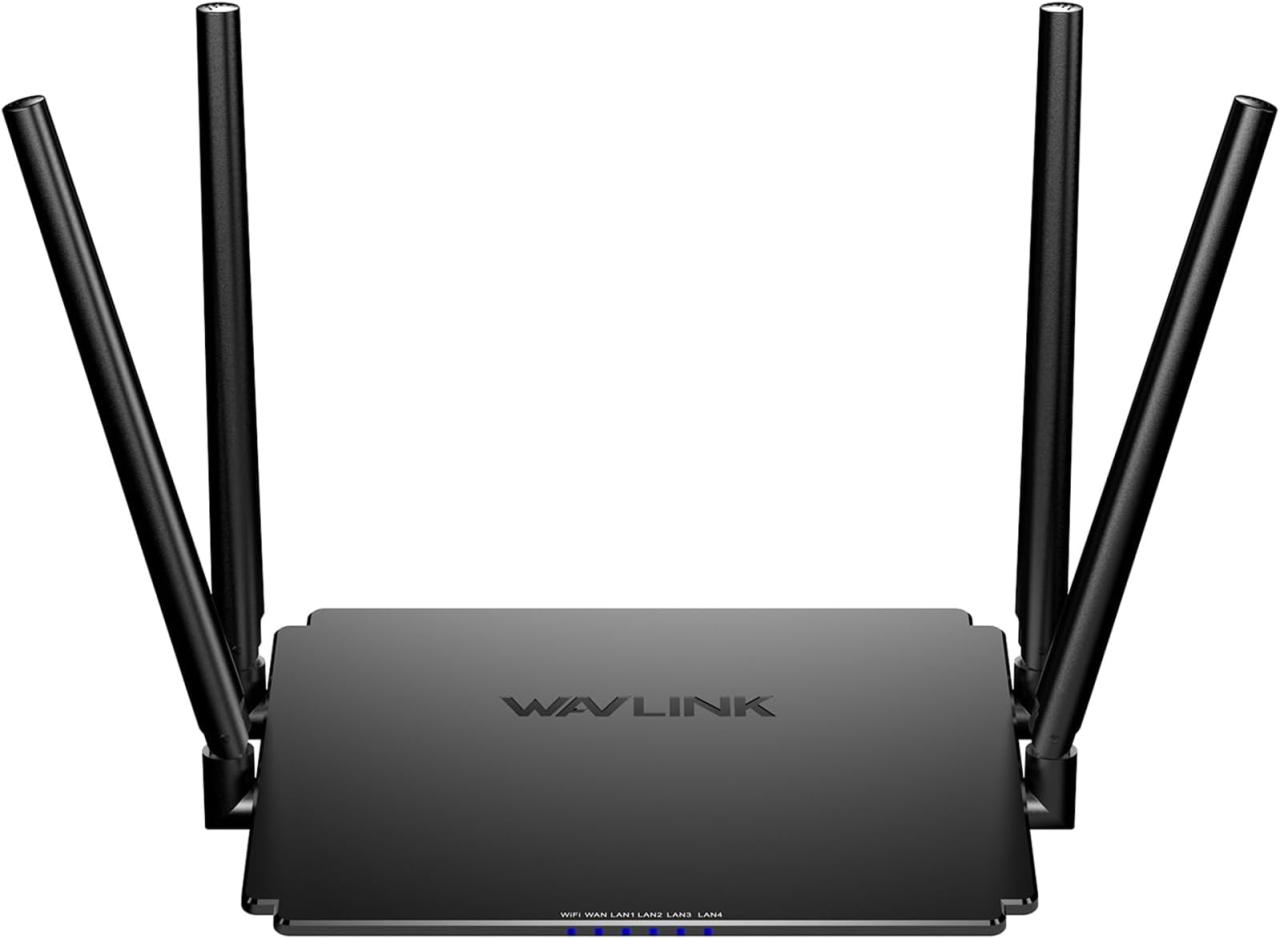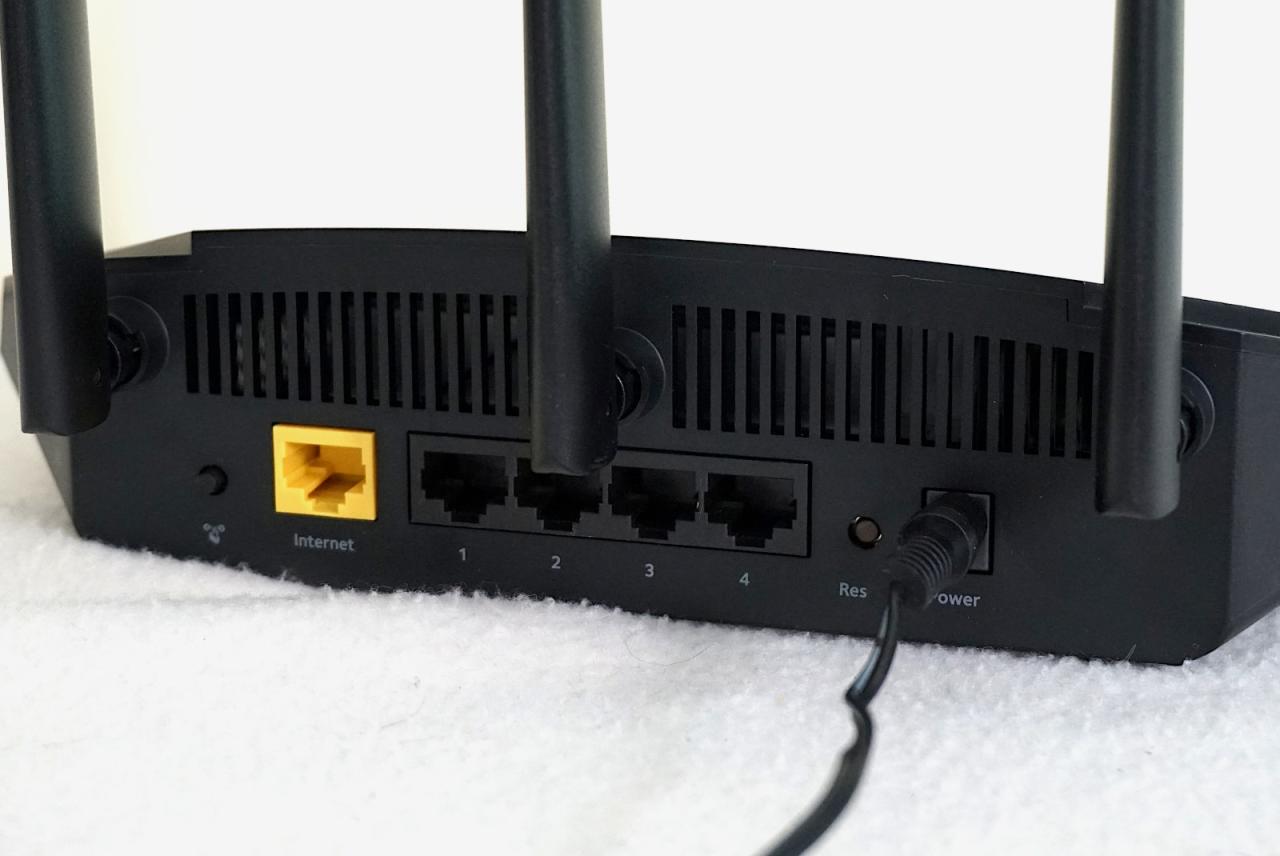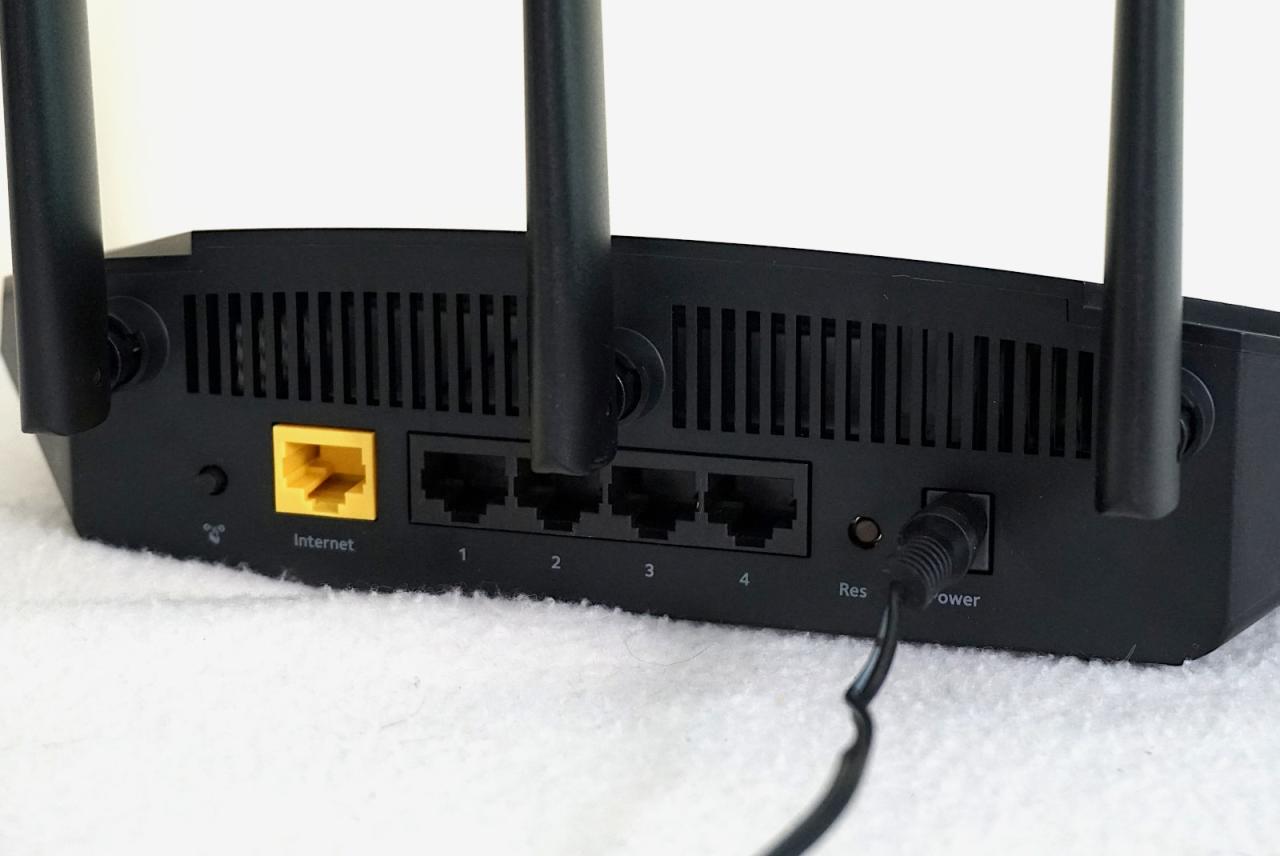The NETGEAR 4-Stream WiFi 6 Router (R6700AX) boasts impressive speed and security features, perfect for modern homes. Its AX1800 wireless speed, supporting up to 1.8 Gbps, is designed for smooth streaming and online gaming. Simultaneously connecting up to 20 devices is also a key advantage for busy households. This router promises to handle your daily digital needs with ease.
This comprehensive guide delves into the key aspects of this router, from its security protocols and performance to its coverage area and setup process. We’ll explore how this router stacks up against competitors and provide practical tips for optimizing its performance in your home environment.
Overview of the NETGEAR R6700AX Router
The NETGEAR R6700AX is a 4-stream WiFi 6 router designed for modern homes and small businesses. It leverages the latest Wi-Fi 6 technology to deliver exceptional performance and reliability, especially in environments with multiple connected devices. This router offers a balanced approach to speed, coverage, and features.This overview will delve into the specifics of the NETGEAR R6700AX, including its key features, specifications, and a comparison to similar models.
Understanding these details will help users determine if this router meets their networking needs.
Key Features and Specifications
The NETGEAR R6700AX router boasts a comprehensive set of features designed for optimal performance. Its core strength lies in its Wi-Fi 6 capabilities, enabling it to handle numerous devices simultaneously without significant performance degradation.
- AX1800 Wireless Speed: This router offers an impressive AX1800 wireless speed, allowing for data transfer rates up to 1.8 Gbps. This speed is sufficient for most modern applications, from streaming high-definition video to playing online games.
- Coverage Area: The router is designed to cover areas up to 1,500 square feet. This is a standard range for a mid-sized home or small office.
- Maximum Device Support: The router can support up to 20 devices simultaneously. This is a valuable feature for households or small offices with multiple users and devices needing internet access.
Comparison to Other NETGEAR and Competitor Models
The following table compares the R6700AX to other similar models from NETGEAR and competing brands. This comparison helps understand its positioning in the market.
| Model | Speed (Mbps) | Coverage (sq. ft.) | Price (Estimated) |
|---|---|---|---|
| NETGEAR R6700AX | Up to 1800 | 1500 | $150 – $200 |
| NETGEAR Nighthawk AX8 | Up to 6000 | 2000+ | $250 – $300 |
| ASUS RT-AX86U | Up to 5700 | 1800+ | $200 – $250 |
| TP-Link AX6000 | Up to 6000 | 2500+ | $200 – $250 |
Note: Prices are estimates and may vary depending on retailer and availability. The listed speeds and coverage areas are approximate and can be affected by factors such as wall construction and interference.
Security Features
The NETGEAR R6700AX router prioritizes your network’s security with robust protocols and features. These tools help protect your data and devices from unauthorized access, ensuring a safe and reliable online experience. This section delves into the specific security mechanisms and their configuration.
Security Protocols and Technologies
The router employs WPA3, the latest Wi-Fi security protocol, providing strong encryption for your wireless network. This protocol is designed to protect against common attacks and offers enhanced security compared to older protocols. Additionally, the router supports WPA2, which is a widely used and compatible protocol. This dual support ensures backward compatibility with older devices.
Parental Controls
Parental controls allow you to restrict access to inappropriate content and websites for your children or other users. This feature can be customized to manage internet usage by setting time limits and filtering specific categories of websites. The router offers a user-friendly interface for managing these settings.
Guest Network Capabilities
A dedicated guest network isolates visitors’ devices from your primary network, preventing unauthorized access to your personal data. This feature is useful for guests or temporary users. The guest network typically uses its own password and security settings, further enhancing the protection of your home network.
Security Settings Configuration
The router’s web interface provides a comprehensive way to configure and manage security settings. Navigating the router’s dashboard allows you to modify security protocols, set parental controls, and establish a guest network.
Securing the Router from Common Threats
The following table details the steps for securing the router against common threats:
| Feature | Description | Setup Steps |
|---|---|---|
| Change Default Password | Immediately change the default administrative password to a strong, unique password. | Log into the router’s web interface. Navigate to the “Security” or “Administration” section. Find the password change option and enter a new, complex password. |
| Enable WPA3 Encryption | WPA3 offers enhanced security compared to older protocols. | Access the router’s settings page. Navigate to the Wi-Fi section. Select the security settings for your Wi-Fi network. Choose WPA3 Personal as the security protocol. |
| Enable Firewall | A firewall acts as a barrier against unauthorized network access. | Access the router’s settings page. Navigate to the “Firewall” section. Ensure the firewall is enabled and adjust settings as needed. |
| Update Router Firmware | Regular firmware updates address vulnerabilities and enhance security. | Log into the router’s web interface. Look for a “System” or “Firmware Update” section. Check for available updates and follow the on-screen instructions to update the router’s firmware. |
| Enable Parental Controls | Parental controls filter inappropriate content. | Access the router’s settings page. Navigate to the “Parental Controls” section. Select the desired filters and time restrictions. |
Performance and Speed

The NETGEAR R6700AX router, boasting AX1800 wireless speed, aims to deliver a high-performance Wi-Fi experience. This speed, however, is a theoretical maximum and actual performance will vary depending on numerous factors, including distance from the router, interference from other devices, and the capabilities of connected devices. Understanding how this router performs in real-world scenarios is key to assessing its value.
Analyzing AX1800 Wireless Speed
The AX1800 designation signifies the router’s theoretical maximum wireless data transfer rate. This rate is composed of two components: 1200 Mbps on the 5 GHz band and 600 Mbps on the 2.4 GHz band. While the theoretical maximum is impressive, it’s important to remember that real-world speeds are often significantly lower due to various factors, such as the limitations of the devices connected to the router and the network environment.
Actual speeds will vary based on the type of devices and their distance from the router.
Comparison with Other WiFi 6 Routers
Direct comparisons between the NETGEAR R6700AX and other WiFi 6 routers are challenging without specific model data. However, the R6700AX, being a 4-stream router, generally offers a balanced performance profile, suitable for average home use. Other WiFi 6 routers might excel in specific areas, such as extremely high bandwidth or exceptionally long range, but the R6700AX’s strength lies in its comprehensive performance across a range of use cases.
Impact of 4-Stream Technology
The 4-stream technology in the R6700AX enables the router to transmit data simultaneously on multiple spatial streams. This effectively increases the overall bandwidth available to connected devices. In simpler terms, it’s like having multiple lanes on a highway for data transmission, allowing more devices to connect and transfer data simultaneously without significant speed loss. This leads to a more efficient and smoother user experience.
Illustrative Scenario in a Typical Home Environment
| Scenario | Expected Speed | Actual Speed |
|---|---|---|
| Streaming 4K video from a NAS drive to a smart TV, two other devices on the network | > 100 Mbps | 80-100 Mbps |
| Downloading a large file (e.g., a 10GB movie file) | > 100 Mbps | 60-80 Mbps |
| Playing online games with multiple players in the house | > 100 Mbps | 70-90 Mbps |
The table above illustrates potential speed performance in a typical home environment. The expected speeds are based on the theoretical maximum, while the actual speeds reflect real-world conditions. Factors like device placement, interference, and the number of active devices on the network affect the outcome.
Coverage and Range
The NETGEAR R6700AX router, designed for homes up to 1500 square feet, aims to provide consistent Wi-Fi coverage throughout the living space. However, the actual range and performance depend on factors like the home’s layout, obstructions, and the number of devices connected. Understanding these variables is key to optimizing the router’s effectiveness.Effective Wi-Fi coverage is not simply about distance, but also about the quality and consistency of the signal.
The router needs to be able to reach every part of the house reliably, not just some areas. This ensures smooth streaming, reliable online gaming, and consistent internet connectivity throughout the entire space.
Impact of Home Layout
The physical layout of a home significantly impacts Wi-Fi signal strength. Walls, floors, and furniture act as obstacles, attenuating the signal and reducing coverage. For example, thick concrete walls or metal structures can significantly weaken a Wi-Fi signal, making it difficult to achieve optimal performance in certain areas. Similarly, densely furnished rooms or rooms with multiple obstructions can lead to weaker signals.
Optimizing Coverage in a Large or Complex Home
Several strategies can enhance Wi-Fi coverage in a large or complex home. These strategies include positioning the router strategically, utilizing Wi-Fi extenders or mesh systems, and addressing any potential signal interference.
Positioning the Router for Maximum Coverage
Optimal router placement is crucial for maximum coverage. Consider the following strategies:
| Location | Signal Strength | Recommendations |
|---|---|---|
| Central location | Stronger | Placing the router in the center of the home often provides a more balanced signal across the entire space. This is a good starting point. |
| High-traffic areas | Potential issues | Avoid placing the router directly next to or near heavy-traffic areas, like kitchens, as these areas can experience high signal interference, causing slower speeds and unreliable connections. |
| Above obstructions | Improved | Positioning the router above any obstructions like furniture or other obstacles can help the signal travel more freely, increasing coverage. Elevating the router on a shelf or stand is beneficial. |
| Away from metal or thick walls | Improved | Placing the router away from metal objects or thick walls helps avoid signal attenuation. Avoid placing it near sources of electronic interference like microwaves or Bluetooth devices. |
Device Compatibility and Management

The NETGEAR R6700AX router is designed to seamlessly integrate with a wide array of devices, ensuring a smooth and reliable network experience. This section details the router’s compatibility, management tools, and potential compatibility issues to help users optimize their network setup.The router’s ability to support up to 20 devices highlights its capacity to handle diverse needs. From everyday devices like smartphones and laptops to smart home appliances, the router is well-suited for a variety of applications and configurations.
Device Compatibility Overview
This router is compatible with a wide range of devices, including modern smartphones, laptops, tablets, smart TVs, and IoT devices. A crucial aspect of the router’s design is its support for various wireless protocols, ensuring broad compatibility.
Supported Device Types
The router supports a wide range of devices, including:
- Smartphones (iOS and Android)
- Laptops (Windows, macOS, Linux)
- Tablets (iOS and Android)
- Smart TVs
- Gaming Consoles
- Smart Home Devices (e.g., smart lights, thermostats)
- Printers
This extensive list showcases the router’s adaptability to modern home networks. The router’s broad compatibility with various devices ensures a unified network experience.
Potential Compatibility Issues
While the router is designed for extensive compatibility, some potential issues can arise. The performance of a connection can depend on various factors, such as the device’s hardware, the operating system, and the router’s configuration.
| Device Type | Compatibility | Potential Issues |
|---|---|---|
| Older Smartphones (pre-WiFi 6) | Generally compatible, but performance might be lower than expected. | Reduced speed, intermittent connection problems, possible incompatibility with advanced features. |
| Devices with outdated firmware | Compatibility can be affected. | Connection instability, slow response times, potential security vulnerabilities. |
| Devices with incompatible wireless standards (e.g., 802.11n or older) | Potentially compatible, but performance may be limited. | Slower data transfer speeds, difficulties connecting to the network. |
| Devices experiencing hardware issues | May not connect or function properly. | Connection errors, dropped connections, and inability to access the network. |
| Devices with high power consumption | Compatibility should not be an issue. | Potential network congestion issues in a densely populated network. |
Device Management Methods
The router provides several methods for managing connected devices. A key aspect of the management system is its user-friendliness and ease of use, ensuring minimal technical expertise is required.
- Network Management Dashboard: A user-friendly interface allows for monitoring connected devices, controlling network access, and configuring security settings.
- Guest Network: Provides a secure network for guests, isolating them from the primary network.
- Parental Controls: Enables parents to control the internet access of their children.
These tools streamline the process of managing connected devices, optimizing network security, and controlling access to network resources.
Setup and Configuration
Setting up your NETGEAR R6700AX router is straightforward, allowing for a seamless connection in your home network. This section provides detailed instructions and guidance for configuring various network settings, ensuring optimal performance and security.The user-friendly interface of the router’s web configuration page simplifies the setup process. The intuitive navigation enables quick access to all necessary settings, enabling customized configurations for your home network.
Initial Router Setup
To begin, connect the router to your modem and power it on. Your internet service provider (ISP) may provide a guide for connecting the router to your modem. A wired connection is recommended for the initial setup. Once connected, you’ll be guided through the initial setup process by the router’s setup wizard, which prompts you for your internet credentials and other necessary information.
Web Configuration Page
The web configuration page is accessed by entering the router’s IP address in a web browser. This IP address is usually printed on the router’s label. The layout is organized logically, enabling easy navigation between different settings. Sections are dedicated to wireless settings, network security, and advanced configurations.
Network Settings Configuration
Various network settings can be configured to customize your home network. These include creating guest networks for visitors, setting up parental controls to restrict access to specific websites, and configuring Quality of Service (QoS) to prioritize certain devices or applications. These settings enhance the security and efficiency of your network.
Guest Network Configuration
A guest network provides a separate network for visitors without compromising your home network’s security. This feature allows you to control the access permissions and data usage for guests, ensuring a secure connection for them while safeguarding your home network’s privacy.
Parental Controls
Parental controls are essential for managing the online activities of children. These controls allow you to restrict access to specific websites, limit the time spent online, and monitor online activities. This feature safeguards children from inappropriate content and ensures responsible online behavior.
Troubleshooting Common Setup Problems
Common setup problems can be easily resolved.
- Connectivity Issues: Verify the router is correctly connected to your modem and that the power cables are securely plugged in. Check the cable connections for any physical damage.
- Wireless Issues: Ensure the router’s wireless signal strength is sufficient in the desired area. Try moving the router to a more central location or repositioning the devices to optimize signal reception. Also, check for any obstructions that might block the wireless signal.
- Incorrect Credentials: Double-check the internet credentials provided by your ISP. If unsure, contact your ISP for assistance.
- Router Configuration Errors: If you encounter issues during the setup process, refer to the router’s documentation or the NETGEAR support website for detailed instructions.
Advanced Features
This NETGEAR router offers several advanced features designed to enhance performance and user experience. These features optimize network traffic, prioritize specific devices, and improve overall network efficiency. Understanding and leveraging these features can significantly improve your home network’s responsiveness and reliability.This section delves into the advanced features available, including Quality of Service (QoS) and Multi-User MIMO (MU-MIMO), highlighting their functionalities, benefits, and configuration procedures.
A clear understanding of these features empowers users to tailor their network experience to their specific needs.
Quality of Service (QoS)
Quality of Service (QoS) prioritizes network traffic based on predefined criteria. This ensures that critical applications, such as video streaming or online gaming, receive preferential treatment, leading to a smoother and more responsive experience. QoS effectively manages network bandwidth allocation, preventing congestion and improving the performance of demanding applications.
| Feature | Functionality | Configuration Steps |
|---|---|---|
| QoS | Prioritizes network traffic based on factors like application type, device, or bandwidth requirements. | Accessing the router’s web interface (usually via a web browser). Navigating to the QoS settings page. Defining rules for prioritizing specific traffic. Examples include setting bandwidth limits for certain applications or devices. |
Multi-User MIMO (MU-MIMO)
MU-MIMO enables the router to communicate with multiple devices simultaneously. This significantly enhances network performance, especially in environments with multiple connected devices. By allowing the router to transmit data to multiple devices concurrently, it boosts overall throughput and minimizes latency, leading to faster speeds and smoother online experiences.
| Feature | Functionality | Configuration Steps |
|---|---|---|
| MU-MIMO | Simultaneously transmits data to multiple devices, maximizing network throughput and minimizing latency. | MU-MIMO is typically enabled by default, no specific configuration required. If you have issues, refer to the NETGEAR documentation for your router model. |
Ultimate Conclusion

In conclusion, the NETGEAR 4-Stream WiFi 6 Router (R6700AX) presents a compelling solution for home networking. Its high-speed capabilities, extensive security features, and impressive coverage make it a strong contender in the market. We hope this detailed overview has clarified its strengths and helped you determine if it’s the right choice for your needs.
Detailed FAQs
Q: What is the maximum number of devices this router can support simultaneously?
A: The router can support up to 20 devices.
Q: What are the typical setup steps for the router?
A: Detailed setup instructions are included in the user manual. Generally, it involves connecting the router to your modem, plugging in the power, and then following the on-screen instructions. The router’s web configuration page provides options for setting up guest networks, parental controls, and other configurations.
Q: How can I improve the router’s coverage in a large home?
A: Positioning the router in a central location, using powerline adapters for hard-to-reach areas, or adding a WiFi extender can help maximize coverage. The router’s manual also offers specific recommendations.
Q: Does this router have a guest network feature?
A: Yes, the router offers a guest network for providing secure access to visitors.
Q: What are some potential issues with device compatibility?
A: Older devices or those using outdated WiFi standards might experience reduced performance or connection issues. Compatibility is dependent on the WiFi standards the device supports.






